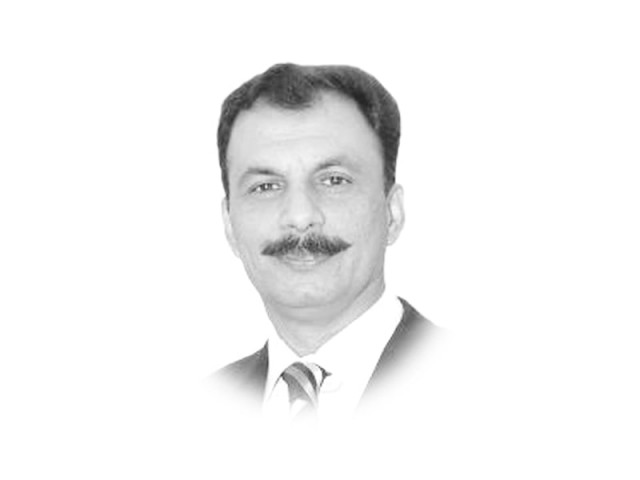The nation state versus violent non-state actors
A state has to be protective, humane. It must act as a shield for innocent citizens, protect them from extremists

The writer is a senior police officer posted to
Khyber-Pakhtunkhwa. He tweets @alibabakhel
In the post-Cold War scenario, patterns of conflict have changed significantly, with armed conflicts not only being waged between states, but also within them. In a post-9/11 world, VNSAs have persistently challenged the legitimacy and power of states. By employing violent tactics, they aim at attaining public support and legitimacy.
VNSAs are organised groups that have command structures which operate outside state control. They induct activists by force and are also able to attract volunteers. In exceptional situations, VNSAs enjoy territorial control, examples being the TTP controlling certain pockets of Fata in the past, the LTTE doing the same in Sri Lanka and the Moro Islamic Liberation Front in the Philippines. Such organisations have clandestine networks and to advance their narrative, they employ the latest propaganda techniques. By using extremely violent tactics against civilian populations, they aim at eroding public confidence in the state and multiply insecurity.
Prior to 9/11, VSNAs were primarily motivated by ethnic considerations. Post-9/11, however, they seem to be gripped by what can be termed ‘millenarianism’, characterised by intense religious fervour, which seems to be their prime motivation. Such militias may not be formally trained, but they have intense focus and are extremely goal-oriented. In certain situations, terrorist groups, organised criminal gangs and smugglers form a nexus, with the result being that some operational functions are entrusted to criminal groups. In exchange, these criminal groups get money and protection from the terrorist group, whose acts of terrorism are primarily carried out to compel states to change their policies. Such policy change is not always favourable for VNSAs, the Pakistani leadership’s response to the APS attack being a case in point.
Through excessive and repeated coverage, the media unconsciously provides oxygen to VNSAs. Before implementation of the NAP, VSNAs routinely claimed responsibility for attacks through the media. However, by barring mass media to accommodate such claims, the NAP has changed such dynamics.
To undermine rival states, countries have often financed, trained and extended diplomatic support to VNSAs. However, such a situation can slip out of control when states fail to realise that the power to hold weapons and run the state should be exclusively exercised by states alone. They cannot afford militias, or parallel administrative and judicial apparatus to wield such powers. VSNAs are often the enemy within as they look like the locals and are thus difficult to identify. They always try to use ungoverned or weakly governed spaces to their advantage. Technological advancements also provide incentives to VNSAs and they often make use of cyber space to meet their ends. For their financing needs, they collect donations from sympathisers and backers, who transmit funds through flawed banking systems and illegal transactions.
To prove their worth, VSNAs have been known to intrude into the inner core of important institutions. Using violent means, they often try to register their presence and seek a permanent role in statecraft. Since 1979, Pakistan has been confronted with the increased penetration of VNSAs. During the insurgency in Malakand and prior to Operation Zarb-e-Azb, VNSAs had persistently challenged the writ of the state. However, after military operations in Malakand and Fata, it has become difficult for VNSAs to register their presence openly. However, sympathisers within the nation state system provide space to such elements. To carry out their criminal activities, like kidnappings for ransom, gun-running and extortion, VNSAs also make use of urban space.
International law primarily applies to states. Therefore, there is no legal space to negotiate with non-state actors. There is now a growing demand for international law to encompass dealings with VSNAs to ensure humanitarian coverage in areas that may be under their control. VNSAs take full advantages of the flaws of the criminal justice system and try to run their own courts, jails and police. To satisfy the victims of crimes, VNSAs often introduce ‘revolutionary justice’ inflicting harsh punishments, like beheadings.
VNSAs often manage to keep their organisational unity intact. However, owing to their power-centric approach, they sometimes face factionalism. In our context, the TTP faced inner groupings that led to their fragmentation. VNSAs often try to introduce new social and cultural values with such tact that they attract those who are already annoyed with the prevailing norms. Beheadings, suicide bombings, attacking shrines and places of worship had never been part of our tribal culture, but now the dynamics have changed. Consequently, we can conclude that VNSAs also resort to cultural terrorism. They also participate enthusiastically in relief activities following natural disasters in order to win the sympathies of the common folk.
Globalisation has provided strength to VNSAs, as planning, training, financing, facilitation and targeting operations are carried out in different parts of the world. The flaw with our approach is that we want to resolve every issue by force. We need to realise that apart from employing a coercive approach, we can also opt for an inclusive approach wherever appropriate. De-radicalisation and reintegration should be top priorities. Extremism is a cancer that infects the followers of different religions, cultures, ethnicities and sects, but it is curable. A living state has to be protective and humane. It must act as a shield for innocent citizens, protecting them from extremists.
Published in The Express Tribune, August 28th, 2015.
Like Opinion & Editorial on Facebook, follow @ETOpEd on Twitter to receive all updates on all our daily pieces.














COMMENTS
Comments are moderated and generally will be posted if they are on-topic and not abusive.
For more information, please see our Comments FAQ